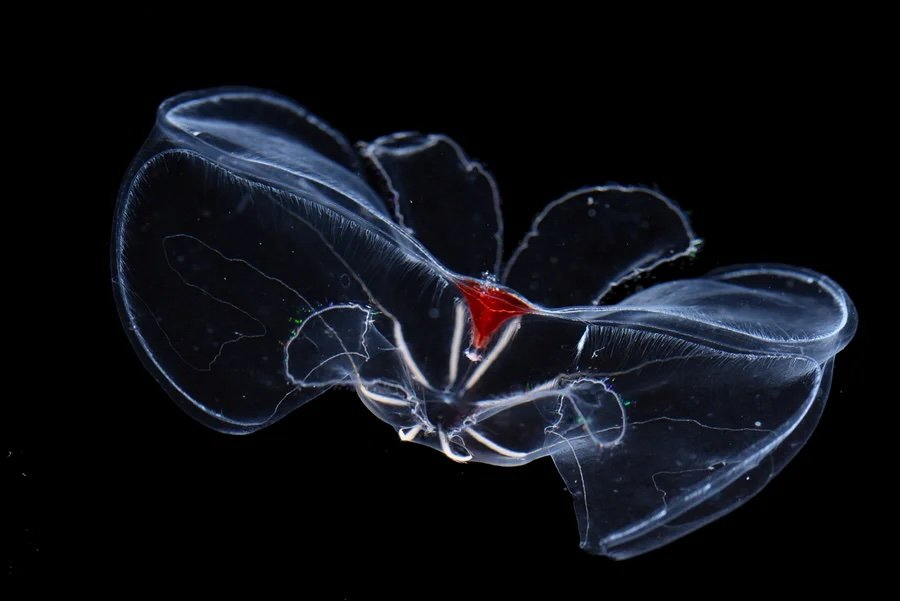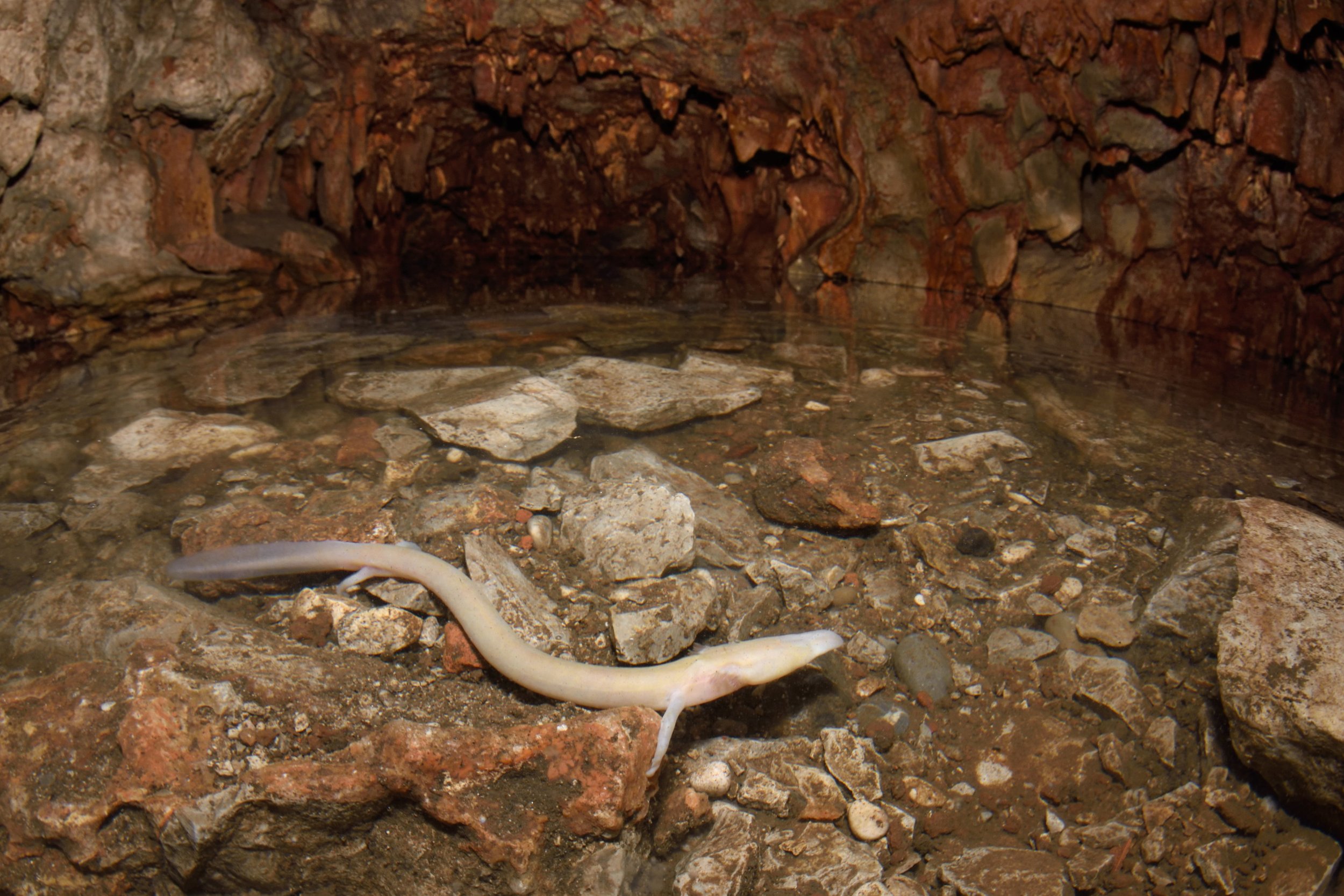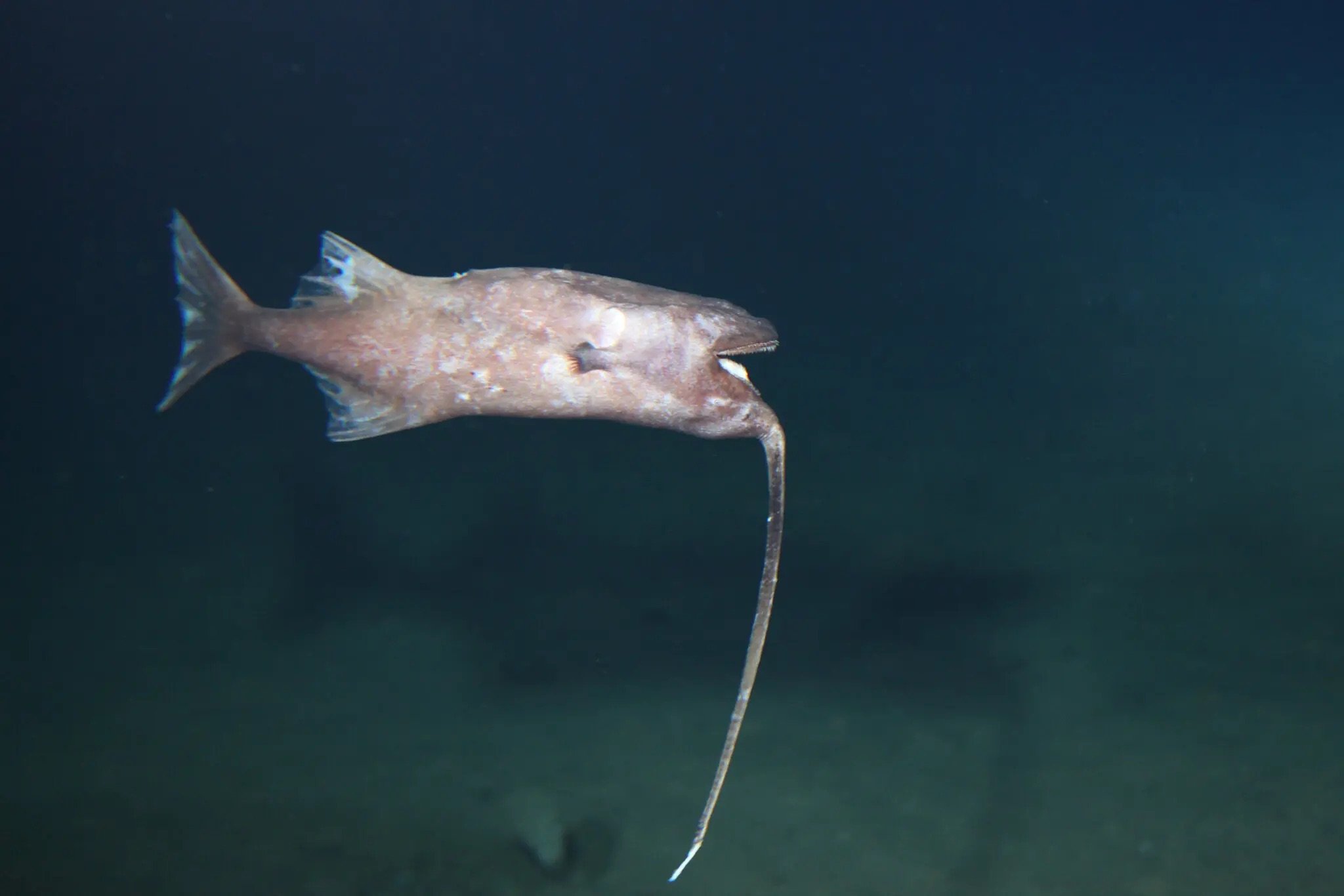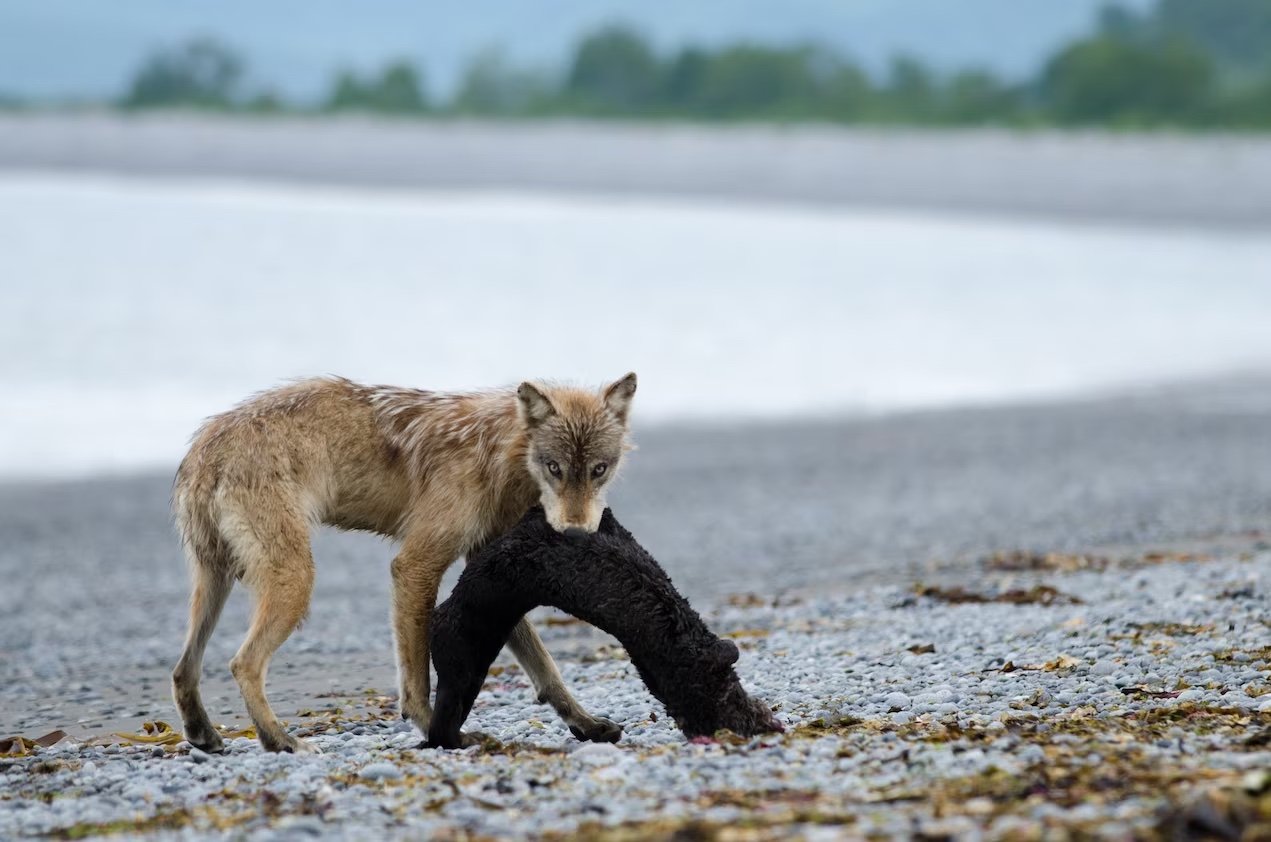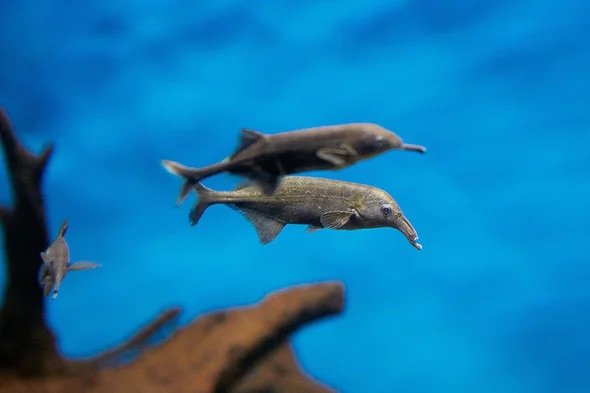Science reporting
New York Times: These Wolves Like a Little Treat— Flower Nectar
The Ethiopian wolf, Africa’s most endangered predator, has a sweet tooth.
While the wolves are otherwise strict meat eaters, scientists have spotted the canids slurping nectar from torch lilies, tall, cone-shaped flowers also known as red hot pokers with nectar that tastes like watered-down honey. And because the wolves’ muzzles get absolutely covered in sticky yellow pollen, researchers suspect they might even be acting as pollinators — a first for a large carnivore. Read more.
National Geographic: Why are women more disgusted than men? It may help them live longer
Cognitive ecologist Cécile Sarabian suggests that the cumulative effects of female disgust—being choosier about what to eat and minimizing exposure to infection—may be one of the reasons why female primates live longer than males.
According to Sarabian, there’s a protective power to “yuck.” Read more.
Scientific American: Comb Jelly with Two Butts Is Actually Two Individuals Fused Together
Closer examination revealed that the jelly with the double derriere had recently been two separate “sea walnut” comb jellies (Mnemiopsis leidyi). After sustaining injuries while being collected the previous day, the comb jellies had fused overnight.
By after grafting additional jellies together, the researchers found that the fusing comb jellies synchronized their respective nervous systems in just two hours. Read more.
Ask NYT Climate: Green Washing, Not Greenwashing: What’s the Best Way to Do Laundry?
Your favorite laundry detergent sends stains and smells packing. But where do those suds go once your clothes are clean? Here’s what to look for to make your laundry not just clean, but green, too. Read more.
Scientific American: Cave Fish Adolescence Means Sprouting Taste Buds in Weird Places
In eastern Mexico’s underground caverns and streams, a blind fish undergoes a peculiar adolescence: as it approaches maturity, taste buds begin to sprout under its chin and on top of its head, creeping toward its back.
And as alien as it may seem, many cells throughout the human body can taste, too. They’re just not sharing the flavors with your brain like taste buds do. Read more.
Ask NYT Climate: Do Countertop Compost Machines Really Work?
Some companies behind newfangled kitchen gadgets claim that they make it easier to keep food waste out of landfills by converting organic waste to compost in a matter of hours, not months. But what do these pricey contraptions really produce? And are any of them really good for the environment? Find out.
New York Times: A Slap of a Honeybee’s Wings Sends Ant Invaders Flying
Scientists in Japan have learned that Asian honeybee guards use their wings to slap pesky ants into next week. Slow-motion video hows what happens when ants try to sneak into the hive’s entrance: The guard bee angles up to the ant like a tennis player setting up a mean backhand, then wing-smacks the ant so hard it tumbles end-over-end through the air as it plummets to the ground. Read more.
Ask NYT Climate: What’s Greenest and Cleanest When Nature Calls?
Conventional toilet paper has a big environmental impact. We’ve got the lowdown on alternatives, from bamboo tissue to bidets. Read more.
Scientific American: How Delicate Comb Jellies Withstand Crushing Depths—But Melt Away on Land
In the ocean’s depths, seawater’s punishing weight would crush most surface-dwelling species to a pulp. So how do ctenophores—squishy, see-through creatures with bodies the consistency of Jell-O—thrive kilometers deep?
Research published in Science explains how deep-sea ctenophores keep it together under extreme pressure and why they “melt” like the Wicked Witch of the West when brought to the surface. “For some deep-sea ctenophores, their cell membranes are literally held together by pressure,” explains the study’s lead author, Jacob R. Winnikoff, a deep-sea biochemist at Harvard University. Read more.
Scientific American: Spiderweb Thread Inspires Ultrasmall Microphones
“Humans, being arrogant animals, fashioned the microphone after their own ears—but that’s not necessarily the best way to do it,” says Ron Miles, a mechanical engineer at Binghamton University.
Instead, Miles contends, why not model microphones on a creature without any ears at all? Taking a cue from arachnid acoustics could alter the future of sound recording. Read more.
Science News: Sumatran orangutans start crafting their engineering skills as infants
At six months old, human infants are still working on sitting up by themselves. But baby orangutans at that age are already developing their engineering skills.
Orangutans build complex sleeping platforms as high as 20 meters in the tree canopy — the equivalent of four stories above the ground — every single evening.
But nest building isn’t instinctive to orangutans — it has to be learned through years of (sometimes hilarious) trial and error that start in infancy. Read more.
Science News: Belugas may communicate by warping a blob of forehead fat
Researchers have created a visual encyclopedia of the different expressions that belugas seem to make with their highly mobile “melon,” a squishy deposit of fat on the forehead that helps direct sound waves for echolocation.
Belugas can extend the melon forward until it juts over their lips like the bill of a cap; mush it down until it’s flattened against their skull; lift it vertically to create an impressive fleshy top hat; and shake it with such force that it jiggles like Jell-O. Read more.
National Geographic: Just one pregnancy can add months to your biological age
A landmark new study confirms that growing a human being from scratch in nine months takes a toll on the body—and multiple pregnancies can have a cumulative effect. Read more.
Scientific American: This Tiny Fish Makes an Ear-Blasting Screech for Love
In the streams of south-central Myanmar lives a creature that could be easily mistaken for a sentient grain of rice—a grain of rice, that is, with a lot to say and a voice like a jackhammer.
At just 12 millimeters long, the transparent fish Danionella cerebrum is among the smallest vertebrates alive, but it may be the world’s loudest animal by weight. But why does such a tiny fish scream so loudly? Sometimes, it seems, “it’s a love song.” Read more. Read more.
New York Times: Subterranean ‘Baby Dragons’ Are Revealed to Sneak to the Surface
Scientists have discovered that blind cave salamanders in northern Italy leave their underground homes to go on expeditions to the surface.
Eyeless and ghostly pale from millions of years spent below ground, the salamanders appear to commute back and forth to the sunny surface using springs where water bubbles up from hundreds of feet deep. Read more.
Scientific American: This Flower Refrigerates Itself to Survive Scorching Summers
Southern Spain’s landscape in high summer is perhaps best described as “crunchy.” Under the unrelenting sun, grass turns to brown straw and most everything green shrivels and dies—that is, except for the clustered carline thistle, a plant with humble yellow flowers and a surprising superpower.
The flowerheads are significantly cooler than their surroundings during the heat of the day, with the difference approaching 18 degrees F. Researchers suggest the plant could essentially be sweating: sacrificing precious water, so scarce in Spain’s arid summers, to prevent its delicate reproductive organs from overheating. Read more.
Scientific American: Bonobos and chimpanzees have surprisingly different parenting styles
Rubin, a baby bonobo, was foraging near his mother Rose in the Congo rain forest when an adult bonobo named Olive snatched some food from Rubin’s tiny hands. Then Olive smacked the baby, hard, in the face and neck—right in front of his mother.
Primatologist Rachna Reddy expected Mom to lay down the law. “I was just like, ‘Gasp! Somebody’s about to get beaten up,’” she says. But to Reddy’s shock, Rose didn’t lift a finger, even as baby Rubin wailed. Read more.
New York Times: Watch ‘Sea Fireflies’ Make Underwater Fireworks as They Seek Mates
Night was falling over the shallow waters of Bocas del Toro, and James Morin, an emeritus professor at Cornell University, flicked on his underwater flashlight to catch a glimpse of the seabed.
Seemingly in answer, hundreds of tiny blue lights sparked to life, rippling out in waves. “We were both kind of swearing into our snorkels in amazement,” said Todd Oakley, a professor at the University of California, Santa Barbara. Read more.
New York Times: A Fish That Fishes for Other Fish Lives Its Life Upside Down
Usually, a belly-up fish isn’t long for this world. But video evidence from the deep ocean suggests that some species of anglerfish — the nightmarish deep-sea fish with bioluminescent lures — live their whole lives upside down.
The behavior, documented earlier this month in the Journal of Fish Biology, is “beyond anyone’s wildest imagination,” said Elizabeth Miller, postdoctoral fellow at the University of Oklahoma. Read more.
National Geographic: Wolves hunt sea otters and seals, a startling find
Patrolling the beach on Alaska’s remote Katmai coast, the white wolf came to the mouth of a creek, where freshwater fed into the salty Hallo Bay.
After about a minute, the predator suddenly lunged forward into the water, clamping its powerful jaws around the tail of a harbor seal—a large-bodied marine mammal that can weigh more than twice as much as an adult wolf.
With a mighty pull, the wolf dragged the seal onto a sandbar, and for the next half hour, the seal futilely snapped at its captor as the wolf continued to tear into its tail. Once the seal died, the wolf trotted away, only to return with a packmate. Together, they devoured their prize.
This scene, filmed by a group of biologists in Katmai National Park and Preserve in 2016, is the first time a wolf has been documented hunting and killing a marine mammal. Read more.
New York Times: Male-Killing Virus Is Discovered in Insects
Scientists in Japan have identified a virus that selectively kills males — and it happens to be inheritable, creating generation upon generation of all females.
The virus was found by chance. Misato Terao, a research technician at Minami Kyushu University, was straightening up the campus greenhouse when she found unwelcome intruders — fat green caterpillars — nibbling on the impatiens. She scooped them up and, on a whim, dropped them off in the lab of Yoshinori Shintani. “It was almost a miracle” they didn’t end up in the trash, he said.
Scientific American: Elephantnose Fish ‘Sees’ by Doing an Electric Boogie
Bats and dolphins are deservedly famous for their echolocation, but the elephantnose fish has a different superpower sense—electrolocation. And now new research suggests this bizarre-looking creature has to do an underwater jig to create the three-dimensional electric map it uses to “see” its surroundings.
It’s got a face like Gonzo the Muppet because of what is technically called its schnauzenorgan—a fleshy protrusion from its chin that’s functionally a cross between an elephant’s trunk and an antenna.
According to a new study published in Animal Behaviour, the elephantnose fish does a little aquatic dance. By wiggling around, it perceives objects from slightly different angles; stacked together, the various electric images it gets are enough for it to distinguish among 3-D objects. Read more.
New York Times: Florida Turtle Nests Are Recovering. When They Hatch, Expect Mostly Girls.
Green sea turtles had an exceptional nesting season on Florida’s beaches in 2023, with volunteers counting more than 74,300 nests, according to preliminary data. That beats the previous record, from 2017, by a staggering 40 percent.
But researchers aren’t ready to claim a conservation victory just yet. Those impressive nesting numbers are just “half the story,” according to Jeanette Wyneken, a professor at Florida Atlantic University who has studied nesting sea turtles for more than three decades.
That’s because, more than most creatures, sea turtles are particularly attuned to a warming climate. In fact, the sex of a baby sea turtle isn’t determined by its DNA but by the temperature of the sand in which its egg developed. Cooler temperatures mean males, warmer ones mean more females. Read more.
National Geographic: Meet the dog who can find rare sea turtle nests at a shocking success rate
A scent-detecting dog named Dory pinpointed the location of sea turtle eggs more accurately than human volunteers, according to recent experiments published in the journal PLOS ONE.
“Conservation sniffers” like Dory could help scientists get a more complete picture of sea turtle nesting habits—crucial information when all U.S. sea turtle species are threatened or endangered, says study leader Rebekah Lindborg, a conservationist with Disney’s Animals, Science, and Environment division. Read more.
New York Times: Hogfish 'See’ With Their Skin, Even When They’re Dead
As a marine biologist, Lorian Schweikert knew hogfish could change color to match their surroundings. But as an angler, she noticed something that wasn’t in the textbooks: Hogfish can camouflage even after they’re dead.
When Dr. Schweikert saw a hogfish with a conspicuous spearfishing hole through its body change color to match the texture of a boat’s deck, “it gave me this idea that the skin itself was ‘seeing’ the surrounding environment,” she said.
New research by Dr. Schweikert and her team provides a compelling explanation for how and why hogfish blend into their background, even in the afterlife. In a study published on Tuesday in the journal Nature Communications, they identified a mysterious new type of cell deep in the hogfish’s skin that might allow the fish not only to monitor its surroundings but also to edit its skin color. Read more.
Science News: Some cannibal pirate spiders trick their cousins into ‘walking the plank’
A Costa Rican pirate spider lives up to the family name: It tricks closely related orb weaver spiders into “walking the plank,” right to their doom.
Like any respectable pirate, pirate spiders have an extensive bag of tricks. Some species delicately strum the threads of other spiders’ webs to convince the arachnids they’ve caught an insect, only to strike when the web owner comes to collect its prey. Others mimic on a web the signature rhythms of a different spider’s courtship dance, luring would-be suitors to their deaths. Read more.
National Geographic: Tonga's volcanic eruption triggered a staggering 2,600 lightning flashes a minute
With hundreds of times more power than an atomic bomb, the Hunga volcano sparked the most intense display of electrical activity ever recorded.
After weeks of grumbling and spitting ash, the underwater caldera near the tiny Kingdom of Tonga reached an unexpected fever pitch on January 15, 2022. In the world’s largest volcanic eruption in more than a hundred years, the Hunga volcano belched 2.3 cubic miles of molten rock and vaporized 146 teragrams of water—enough to fill 58,000 Olympic swimming pools.
But what really rattled volcanologists? The initial readings showed an enormous ring of lightning expanding from the eruption’s epicenter at around 180 miles per hour. Read more.
New York Times: Your DNA Can Now Be Pulled From Thin Air. Privacy Experts Are Worried.
David Duffy, a wildlife geneticist at the University of Florida, just wanted a better way to track disease in sea turtles. Then he started finding human DNA everywhere he looked.
The results of his research, published Monday in the journal Nature Ecology & Evolution, demonstrate that scientists can recover medical and ancestry information from minute fragments of human DNA lingering in the environment.
Forensic ethicists and legal scholars say the Florida team’s findings increase the urgency for comprehensive genetic privacy regulations. For researchers, it also highlights an imbalance in rules around such techniques in the United States — that it’s easier for law enforcement officials to deploy a half-baked new technology than it is for scientific researchers to get approval for studies to confirm that the system even works.
This story was the New York Times’ ‘the Great Read’ on May 15 and ran as the Science Times’ cover story in the May 16 print edition.
National Geographic: Hidden DNA is revealing secrets of animals’ lives
In the last decade or so, environmental DNA, or eDNA, has revolutionized marine and aquatic research by allowing scientists to sample “an entire ecosystem” with a liter of water. Now, after a flurry of experiments on dry land in the past several years, eDNA has become biologists’ skeleton key. It’s a relatively cheap, noninvasive, and simple technique that can be modified to study any form of life, and it often requires less time and labor to employ than previous methods.
Here’s a sampling of the most surprising places scientists have found hidden DNA—from beaches to beetles’ bellies to the wind—and what these discoveries are teaching us. Read more.
National Geographic: Celebrate America with photos of our unique species
This Fourth of July, we’re honoring the creatures that make the United States rich—in biodiversity, that is.
Scroll through the gallery to learn more about the animals that share our country, from the Gila monster—who needs a new public relations strategy—to the vernal pool fairy shrimp. Read more.
National Geographic: Why this newly identified polar bear subpopulation is so special
It’s tempting to read the study as a new hope that polar bears can survive with less sea ice, but the authors emphasize that the conclusion isn’t that polar bears will be more resilient to climate change than previously believed. It’s that places like the southeast of Greenland—where ice from freshwater glaciers can make up for lost sea ice—could be where polar bears make their last stand. Read more.
MIT Tech Review: The cameras that capture fragile deep-sea jellies in their element
The strange inhabitants of the oceans’s midwater, also called the twilight zone, are notoriously difficult to study. Their bodies are so insubstantial that capturing them has been likened to trying to catch fog in a net and then pickle it in a jar. Even if you do manage to capture specimens intact, they tend to dissolve in preservatives.
But two new imaging systems promise to help researchers describe these fragile species for the first time and perhaps even reduce the time between the first discovery of a creature and its formal introduction to science—which a 2012 study calculated takes an average of 21 years. Read more.
National Geographic: For the first time, wild dolphin observed 'talking' with harbor porpoises
On Scotland’s west coast is the Firth of Clyde, a large saltwater inlet home to thousands of harbor porpoises—and one dolphin named Kylie.
New research published in Bioacoustics this January suggests Kylie’s ties to porpoises are closer than scientists imagined. While a common dolphin’s vocal repertoire should include a diverse range of clicks, whistles, and pulse calls, Kylie doesn’t whistle. Instead, she “talks” more like harbor porpoises, which communicate using high-pitched bursts of clicks.
The study suggests that she may be communicating with the porpoises, or at least attempting to. It’s part of a growing body of work that illuminates a rich world of interactions between different cetacean species. Read more.
National Geographic: Snow is glowing in the Russian Arctic. The culprit? Tiny sea creatures.
High in the Russian Arctic, at a remote field station on the shores of the White Sea, biologist Vera Emilianenko set out for a walk on a frigid December night. With her were Mikhail Neretin, the son of the station’s molecular biologist, and a couple dogs: a giant schnauzer and soft-coated Wheaten terrier.
Trudging along the icy embankments of the tidal zone in fierce Arctic winds, Neretin spotted a blue illumination in a snowbank. Had Emilianenko dropped her phone?
As they walked over to investigate, their footsteps created streaks of ethereal blue. “They were like blue Christmas lights in the snow,” Emilianenko says. Read more.
National Geographic: This fierce fish grows 20 new teeth each day
The Pacific lingcod is an ill-tempered, omnivorous fish with a mouth like a messy silverware drawer, its 500-plus teeth arranged haphazardly on two sets of highly mobile jaws. New research, published this month in the scientific journal Proceedings of the Royal Society B, reveals that the Pacific lingcod gains and loses an average of 20 teeth every day. Read more.
National Geographic: Birds flocked to cities during COVID-19 lockdowns
The “anthropause,” as scientists have dubbed the abrupt slowdown of human movement during the first wave of lockdowns, has allowed researchers an unprecedented opportunity to see how animals behave with less interference from us.
The results suggest many species respond quickly to even modest changes in human traffic—with important implications for conservation. Read more.
National Geographic: Lasers, cannons, effigies: The surprising science of shooing vultures away
SINCE the early 2000s, researchers have developed an arsenal—more like a toybox, really—of tools to humanely encourage vultures to move along. The government’s latest addition? Tube men, the flailing balloon guys outside car dealerships. Read more.
Washington Post: Our eyes may provide early warning signs of Alzheimer’s and Parkinson’s
FORGET the soul — it turns out the eyes may be the best window to the brain. Changes to the retina may foreshadow Alzheimer’s and Parkinson’s diseases, and researchers say a picture of your eye could assess your future risk of neurodegenerative disease.
Pinched off from the brain during embryonic development, the retina contains layers of neurons that seem to experience neurodegenerative disease along with their cousins inside the skull. The key difference is that these retinal neurons, right against the jellylike vitreous of the eyeball, live and die where scientists can see them. Read more.
National Geographic: How the ‘tiny tanks of the Amazon’ survive piranha bites
RESEARCHERS IN A California biomechanics lab recently staged what should have been the most lopsided freshwater cage match of all time. In one corner was a red-bellied piranha, the razor-toothed terror of the Amazon. In the other was a three-striped cory, a faintly dopey-looking catfish about an inch long.
The piranha edged the cory into a corner, opened wide and chomped down once, twice, ultimately 10 times—only for the catfish to wriggle free and drift off unfazed, if a little miffed.
How can this small fish take such abuse? Read more.
National Geographic: How humans are hijacking scent, the universal animal language
THE VILLAGERS OF Maharashtra state held their breath as the body count climbed.
Animal activists knew her as Avni. The Indian government called her T1. But no one knew quite what to do with the tiger, the mother of two cubs who was blamed for 13 mauling deaths in two years.
The Indian government deployed a small army to bring Avni in. Hundreds of foot soldiers, infrared drones, paragliders, snipers, and elephants combed the jungle fruitlessly for nearly two months…. Read more.
National Geographic: How humans are messing up bee sex
FLY FAST AND die young: That’s a male honeybee’s lot in life. With less than a one percent chance of successful reproduction, and a 100 percent chance of dying after mating, male honeybees have it tough.
But recent evidence suggests that human activity—including land development, electromagnetic pollution, and use of neonicotinoid pesticides—is making it even harder for honeybees to reproduce, to the peril of the species.
Every spring these males, also known as drones, fly out to congregation areas, mid-air ballrooms where thousands of young bees gather from miles around to show their stuff…. Read more.
National Geographic: Widely misinterpreted report still shows catastrophic animal decline
THE WORLD WILDLIFE FUND For Nature’s Living Planet Report released this week describes a catastrophic decline in animal populations the world over. But it was widely misinterpreted by many outlets, with headlines wrongly insisting that we’ve lost 60 percent of all animals over the course of 40 years. The reality is more nuanced, though still alarming…Read more.
National Geographic: Bizarre Newts Live Their Whole Lives, and Reproduce, As Babies
LIKE PETER PAN, the alpine newt sometimes refuses to grow up.
In their juvenile form, these alpine newts slurp up plankton in the icy mountain pools they call home, as high as 8,000 feet above sea level in the European Alps. A distinctive frilly crown of gills, used to filter oxygen from the water, marks them as larvae, the newt equivalent of what tadpoles are to frogs.
Every generation, a handful of alpine newts simply opt not to leave their watery cradle. These big babies are called paedomorphs, a term meaning "child form," and they fend off metamorphosis for months, years, or even a lifetime—but they can still reproduce. Read more.
National Geographic: How Deep-Sea Fish Are So Exceptionally Black
In the vast, featureless darkness of the oceans, fish take camouflage to a new art form. How do you blend in with nothing?
"When you look at them, especially in the water, it’s just like a hole in the universe," says Sönke Johnsen, a marine biologist at Duke University who studies the denizens of the deep.
Duke Energy forgot protocols when hydro station failed. Trout died. Will Nantahala rebound?
BRYSON CITY — It was like watching someone suffocate.
On July 28, Paul Bourcq raced out to his old haunts on the Nantahala, the river that snakes through Nantahala National Forest in Swain County, to see what had sent his angler friends spiraling into panic.
In every eddy he searched, Bourcq found about a dozen mature rainbow trout dead or dying. Those still alive swam in dazed circles on the surface, wobbling like they’d received a blow to the head. The dead swirled with the eddies, their discolored bodies thumping against rocks until they were swept downstream or sank to the bottom.
The next day, tourists rushed to buy fishing nets from angler Nick Johnson at a river outfitter. They'd caught several stunned trout with their bare hands, but figured they could haul away dozens of fish with nets.
Puppy mill survivors are paralyzed with fear. APSCA learned to save almost all of them.
WEAVERVILLE - In the aftermath of a puppy mill bust, the youngest dogs are often ready for adoption as soon as they're weaned and given a good scrubbing.
But after years of abuse and isolation, the older dogs need far more than a bath.
Responding to cruelty cases nationwide, behaviorists at the American Society for the Prevention of Cruelty to Animals found themselves overwhelmed with dogs that were literally afraid of their own shadows — they'd never seen them before, because they'd never seen sunlight. Read more.






